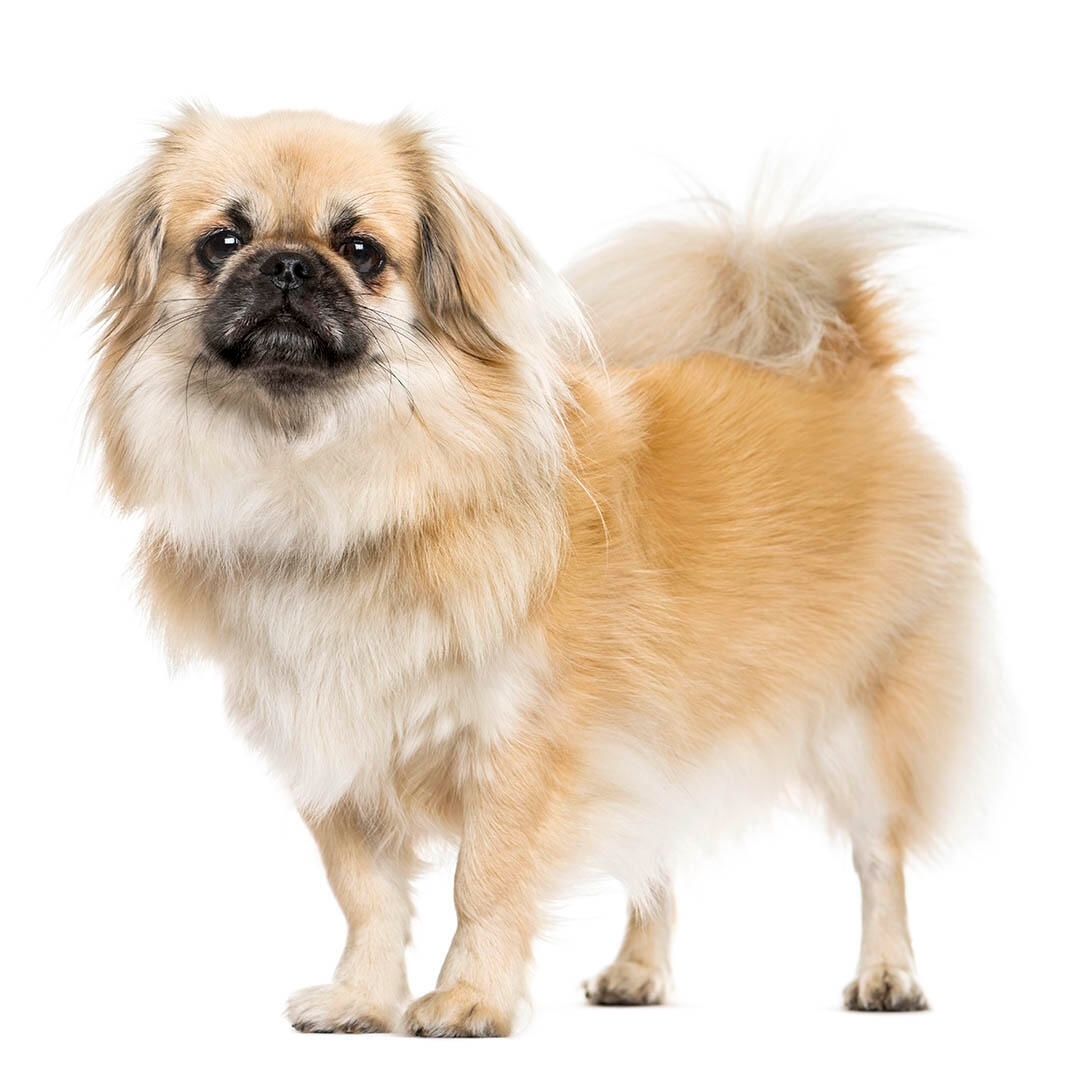
| Family-friendly: | 5/5 |
| Exercise needs: | 4/5 |
| Easy to train: | 4/5 |
| Tolerates being alone: | 1/5 |
| Likes other pets: | 4/5 |
| Energy level: | 3/5 |
| Grooming needs: | 3/5 |
| Shedding: | 3/5 |
The Tibetan Spaniel dog breed is classed as brachycephalic; problems associated with the condition include;
- Brachycephalic obstructive airway syndrome: a condition in brachycephalic breeds (those with a short nose and squashed face) where breathing is obstructed and can lead to reduced ability to exercise, or even severe respiratory distress.
- Skin inflammation/infection: brachycephalic breeds have a short nose and a normal amount of facial tissue. This means there is often excess skin around their face which leads to skin folds. The skin inside these folds can become sore and infections are prone to develop.
- Eye ulcers: ulcers are painful erosions on the surface of the eye. They are more common in brachycephalic breeds due to their conformation, as their eyes tend to be more bulbous.
The breed can also suffer from:
- Patellar luxation
- Progressive retinal atrophy which is an inherited disorder where part of the eye degenerates and wastes away which can result in blindness.
Priority Kennel Club health schemes and testing:
- Eye screening scheme
Alert and active, the Tibetan Spaniel may be reserved with strangers, yet completely loyal to family. As a companion breed they do not like to be separated from their owner or family, and this is something they must be trained to cope with and even then something they may always struggle with. They have a natural tendency remains to alert owners to whatever is occurring, and this breed trait should not be ignored as they can be extremely vocal.
| Family-friendly: | 5/5 |
| Exercise needs: | 4/5 |
| Easy to train: | 4/5 |
| Tolerates being alone: | 1/5 |
| Likes other pets: | 4/5 |
| Energy level: | 3/5 |
| Grooming needs: | 3/5 |
| Shedding: | 3/5 |
Bred in Tibet by the monks to act as watchdogs within the monasteries, the Tibetan Spaniel is a spaniel in name only, they have no genetic link to the gundog spaniels, but most likely took the name as they slightly resemble the toy spaniel types.
In their original role as watchdogs, the Tibetan Spaniel would climb walls to seek out high vantage points from which to watch, and bark an alarm should someone approach. This behaviour can still be seen in modern Tibetans, whose owners will frequently find them on worktops, table tops and window sills. No, they cannot levitate, they are just extremely gifted climbers!
It is also possible the Tibetan Spaniel performed another function for the monks, in turning the prayer-drums that contained the prayer on a scroll. Each rotation counted as a prayer ‘said’ and this extra duty would give one reason why the Tibetan Monks had several small breeds that worked for them.
This attractive little watchdog needs owners who understand that despite their small size, they firmly believe they’ve a job to do – that is to watch everything, and alert you to anything they deem suspicious. Even with excellent socialisation and training, that is still a broad category! Ideal owners will enjoy training tricks and games as well as basic manners, be active and capable of fun and engaging walks, and enjoy grooming to keep that pretty coat clean and healthy. A fun family breed for those with prior dog owning experience who are at home most of the time.
An hour’s exercise per day, as well as some training and games in the form of puzzle solving, clicker training and feeding from food dispensing toys should keep the Tibetan Spaniel busy and satisfied. A secure garden is a must as the Tibbie is an excellent digger!
The Tibetan Spaniel is not a demanding dog to house, a secure garden is vital and it is worth considering how loud or busy your local area is, as this breed is likely to be overstimulated and stressed by constant noise. As long as this is taken into account, the Tibetan Spaniel will happily live in country or town housing.
Small dogs have a fast metabolism, meaning they burn energy at a high rate, although their small stomachs mean that they must eat little and often. Small-breed foods are specifically designed with appropriate levels of key nutrients and smaller kibble sizes to suit smaller mouths. This also encourages chewing and improves digestion.
The double coat consists of a fine, dense undercoat and a longer, silky topcoat. Brush and comb through the coat a couple of times a week, paying particular attention to the feathering, which is prone to tangling and the fur between the pads which can easily mat or collect debris.
Easily trained this breed is quick to learn and loves to spend time with their owner, positive reinforcement training will get the best out of this little dog. Although small the Tibetan Spaniel should be capable of a variety of dog activities including tracking, man-trailing and mini agility and it is well worth having a go at some of these activities to keep their minds occupied.
Gentle and kind, the Tibetan Spaniel can make an excellent family pet. Caution is advised with very small children as it is very easy for them to mistake small fluffy breeds for toys. Not ideal for the very busy family who have long periods of absence from the home.
While many dogs are traditionally thought of as being good with children, all dogs and children need to be taught to get on with and respect each other, and be safe together. Even so, dogs and young children should never be left alone together and adults should supervise all interactions between them.